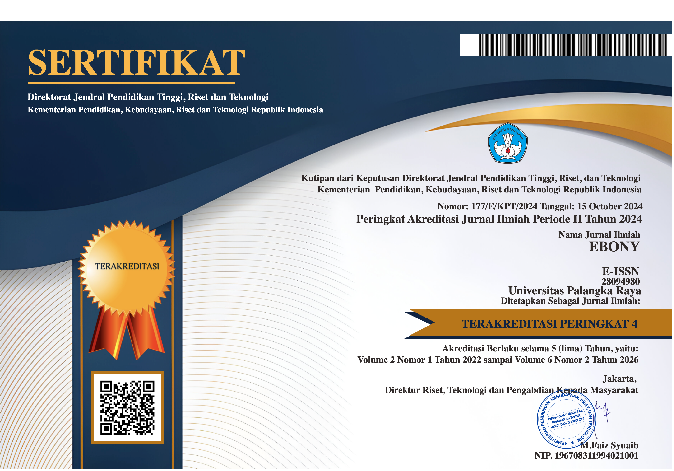Value Engagement of TikTok: A Review of TikTok as Learning Media for Language Learners in Pronunciation Skill
DOI:
https://doi.org/10.37304/ebony.v3i2.9605Keywords:
Exolyt, Language learners, Learning media, Pronunciation, TiktokAbstract
This study describes the use of TikTok as a medium for Language Learners in learning pronunciation. This study uses a descriptive qualitative. The research uses Exolyt as an analytical tool to determine engagement values including clicks, comments, and shares. The researcher uses five popular content creators, namely @englishwithgeet, @english.with.luccy, @englishwithcarla, @englishwithnab, and @andreaholmenglish. The analysis shows that the pronunciation category has the highest engagement because pronunciation is one of the important elements in English speaking and short video duration is very suitable for this category. It shows clear sound, images, filters, and material in the delivery of material, attractive images (right light), and the influence of the creator and material presented is more specific and clear. These videos from @english.with.lucyy and @englishwithnab consist of phonetic symbols. The use of the phonetic symbol is important in learning pronunciation to make it easier for viewers or English learners in pronouncing English words correctly. Besides pronunciation, the learners also can learn grammar, vocabulary, and common mistakes in English. TikTok application, together with the proper use and method can be used as an interesting, interactive, and innovative learning medium in learning even teaching English.
Downloads
References
Aboe, R. M. (2018). Buku Ajar Pronunciation Practice. Deepublish.
Ahlquist, J. (2020). Digital Leadership in Higher Education: Purposeful Social Media in a Connected World. Stylus Publishing, LLC.
Aji, W. N., & Setiyadi, D. B. P. (2020). Aplikasi Tik Tok Sebagai Media Pembelajaran Keterampilan Bersastra. Metafora: Jurnal Pembelajaran Bahasa dan Sastra, 6(1), Article 1. http://jurnalnasional.ump.ac.id/index.php/METAFORA/article/view/7824
Brach, K. (2020a). Hacks for TikTok: 150 Tips and Tricks for Editing and Posting Videos, Getting Likes, Keeping Your Fans Happy, and Making Money. Simon and Schuster.
Brach, K. (2020b). Hacks for TikTok: 150 Tips and Tricks for Editing and Posting Videos, Getting Likes, Keeping Your Fans Happy, and Making Money. Simon and Schuster.
Dakhi, S., & Fitria, T. N. (2019). The Principles and the Teaching of English Vocabulary: A Review. JET (Journal of English Teaching), 5(1), Article 1. https://doi.org/10.33541/jet.v5i1.956
Dewanta, A. A. N. B. J. (2020). Pemanfaatan Aplikasi Tik Tok Sebagai Media Pembelajaran Bahasa Indonesia. Jurnal Pendidikan dan Pembelajaran Bahasa Indonesia, 9(2), Article 2. https://ejournal-pasca.undiksha.ac.id/index.php/jurnal_bahasa/article/view/3491
Fauzi, I. (2021). The Variability in Phonology of Indonesian Learner’s Interlanguage: A case study on English marked-fricatives. International Journal of Language Education (IJOLE), 5(4), 285-295.
Finlayson, K. (2016). The Little Book of Building Vocabulary. Bloomsbury Publishing.
Firamadhina, F. I. R., & Krisnani, H. (2020). Perilaku Generasi Z Terhadap Penggunaan Media Sosial Tiktok: TikTok Sebagai Media Edukasi dan Aktivisme. Share : Social Work Journal, 10(2), Article 2. https://doi.org/10.24198/share.v10i2.31443
Fitria, T. N. (2019). Errors in Students’ Writing Composition in Simple Present Tense “MY DAILY ACTIVITY.” EDULANGUE, 2(1), Article 1. https://doi.org/10.20414/edulangue.v2i1.318
Fitria, T. N. (2020). Error Analysis Found in Students’ Writing Composition in Simple Past Tense of Recount Text. ENGLISH FRANCA : Academic Journal of English Language and Education, 4(2), Article 2. https://doi.org/10.29240/ef.v4i2.1154
Fitria, T. N. (2022). Using Authentic Material and Created Material (Teacher-Made) for English Language Teaching (ELT): Benefits and Limitations. JADEs Journal of Academia in English Education, 3(2), Article 2. https://doi.org/10.32505/jades.v3i2.4674
Gilakjani, A. P. (2012). The Significance of Pronunciation in English Language Teaching. English Language Teaching, 5. https://doi.org/10.5539/elt.v5n4p96
Hageny, R. (2021). Common Mistakes You Make When Using English: Exercises for Practicing English in A Correct Way: How to Avoid English Mistakes. Independently Published.
Hancock, M., & Donna, S. (2012). English Pronunciation in Use Intermediate with Answers, Audio CDs (4) and CD-ROM. Cambridge University Press.
Lapan, S. D., Quartaroli, M. T., & Riemer, F. J. (2011). Qualitative Research: An Introduction to Methods and Designs. John Wiley & Sons.
Literat, I. (2021). “Teachers Act Like We’re Robots”: TikTok as a Window into Youth Experiences of Online Learning During COVID-19. AERA Open, 7, 2332858421995537. https://doi.org/10.1177/2332858421995537
Luisandrith, D. R., & Yanuartuti, S. (2020). Interdisiplin: Pembelajaran Seni Tari Melalui Aplikasi Tik Tok Untuk Meningkatkan Kreativitas Anak. Jurnal SeniTari, 9(2), 6.
Nabilah, A., M.p, D. L., Lazuwardiyyah, F., Syaifuddin, S., & Abdi, W. M. (2021). Students’ perception toward the use of tiktok video in learning writing descriptive text at MAN 1 Gresik. Journal of Research on English and Language Learning (J-REaLL), 2(1), Article 1. https://doi.org/10.33474/j-reall.v2i1.9017
Namaziandost, E., Esfahani, F. R., & Hashemifardnia, A. (2018). The Effect of Teaching Phonological Rules on English Pronunciation Among Iranian Pre-Intermediate EFL Learners. European Journal of English Language Teaching, 0(0), Article 0. https://doi.org/10.46827/ejel.v0i0.1626
Ostrowski, D. (2020). Business English through Coaching and Conversation: Teaching English Online. David Barkham.
Pratiwi, A. E., Ufairah, N. N., & Sopiah, R. S. (2021). Utilizing Tiktok Application As Media For Learning English Pronunciation. International Conference on Education of Suryakancana (IConnects Proceedings), 0(0), Article 0. https://doi.org/10.35194/cp.v0i0.1374
Quesenberry, K. A. (2020). Social Media Strategy: Marketing, Advertising, and Public Relations in the Consumer Revolution. Rowman & Littlefield.
Ramadhan, R. (2020). Aplikasi Tiktok Sebagai Media Pembelajaran Bahasa Arab Baru Dizaman Digital. Multaqa Nasional Bahasa Arab, 3(1), Article 1. https://munasbauai.com/index.php/mnba/article/view/118
Riaz, S., Jaffer, B., & Mushtaq, A. (2019). Living in a Moment: Impact of TikTok on Influencing Younger Generation into Micro-Fame. International Journal of Knowledge Content Development & Technology. https://doi.org/10.31620/JCCC.12.19/19
Schellewald, A. (2021). Communicative Forms on TikTok: Perspectives from Digital Ethnography. International Journal of Communication, 15(0), Article 0.
Singh, S., & Diamond, S. (2020). Social Media Marketing for Dummies. John Wiley & Sons.
Smakman, D. (2019). Clear English Pronunciation: A Practical Guide. Routledge.
Smith, A. (2020). TikTok User Guide: Super Useful Tips to Demystify, Master, and Get More out of TikTok without Breaking a Sweat. Fehintola Otegbeye.
Stringer, E. T., & Aragón, A. O. (2020). Action Research. SAGE Publications.
Taubah, M. (2020). Aplikasi Tik Tok Sebagai Media Pembelajaran Maharah Kalam. Mu’allim Jurnal Pendidikan Islam, 2(1), 10.
Verica, B., & Zlatko, N. (2020). Handbook of Research on Enhancing Innovation in Higher Education Institutions. IGI Global.
Warini, N. L., Dewi, N. P. E. S., Susanto, P. C., & Dewi, P. C. (2021). Daya Tarik Tiktok Sebagai Media Pembelajaran Bahasa Inggris Online. Seminar Ilmiah Nasional Teknologi, Sains, Dan Sosial Humaniora (SINTESA), 0(0), Article 0. https://jurnal.undhirabali.ac.id/index.php/sintesa/article/view/1230
Wayne, R. (2020). TikTok Marketing Profits. Estalontech.
Whitehead, C. R. (2020). Becoming a Digital Parent: A Practical Guide to Help Families Navigate Technology. Routledge.
Wilson, A. (2020). Social Media Marketing: Ultimate User Guide to Facebook, Instagram, YouTube, Blogging, Twitter, LinkedIn, TikTok, Pinterest. Adidas Wilson.
Xu, L., Yan, X., & Zhang, Z. (2019). Research on the Causes of the “Tik Tok” App Becoming Popular and the Existing Problems. Journal of Advanced Management Science, 59–63. https://doi.org/10.18178/joams.7.2.59-63
Yang, H. (2020, June). Secondary-school Students’ Perspectives of Utilizing Tik Tok for English learning in and beyond the EFL classroom. 2020 3rd International Conference on Education Technology and Social Science. https://doi.org/10.23977/ETSS2020030
Zaitun, Z., Hadi, M. S., & Indriani, E. D. (2021). TikTok as a Media to Enhancing the Speaking Skills of EFL Student’s. Jurnal Studi Guru Dan Pembelajaran, 4(1), Article 1.
Downloads
Published
How to Cite
Issue
Section
License
Copyright (c) 2023 Tira Nur Fitria

This work is licensed under a Creative Commons Attribution 4.0 International License.











